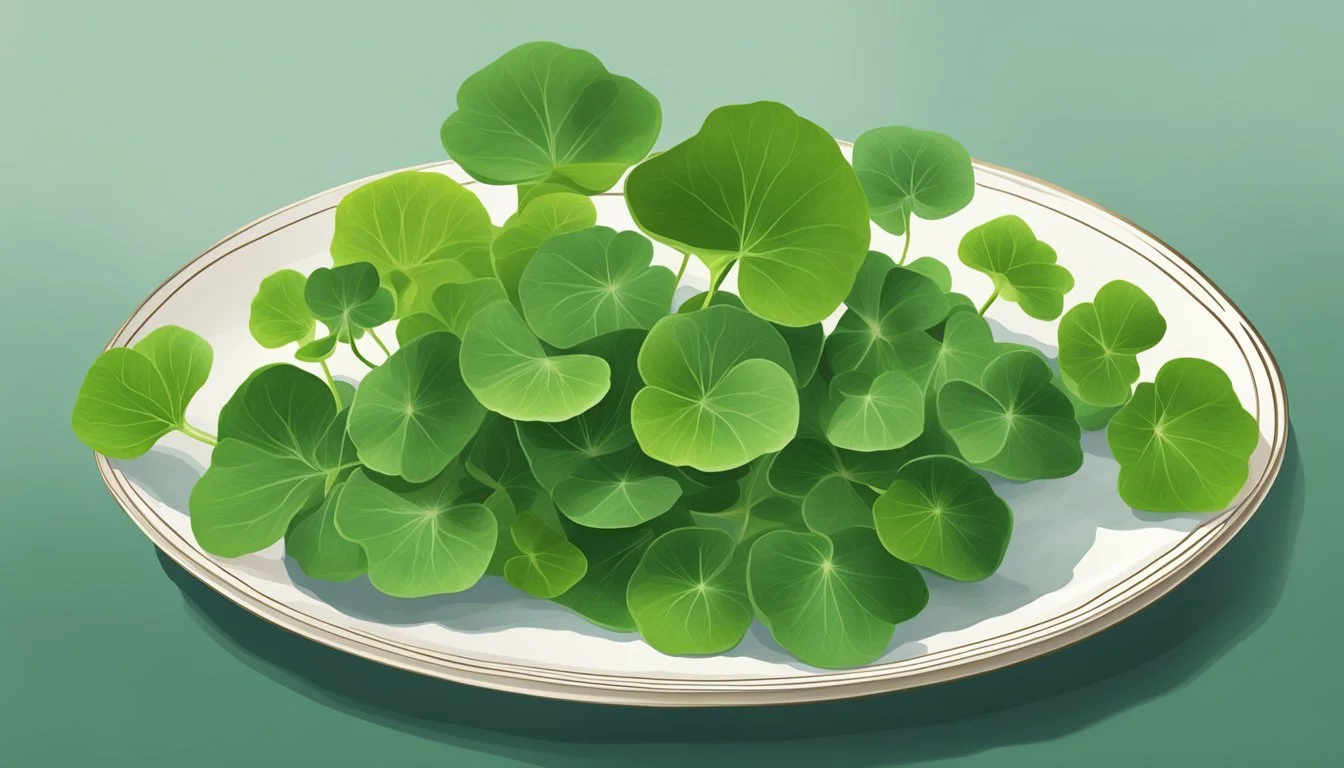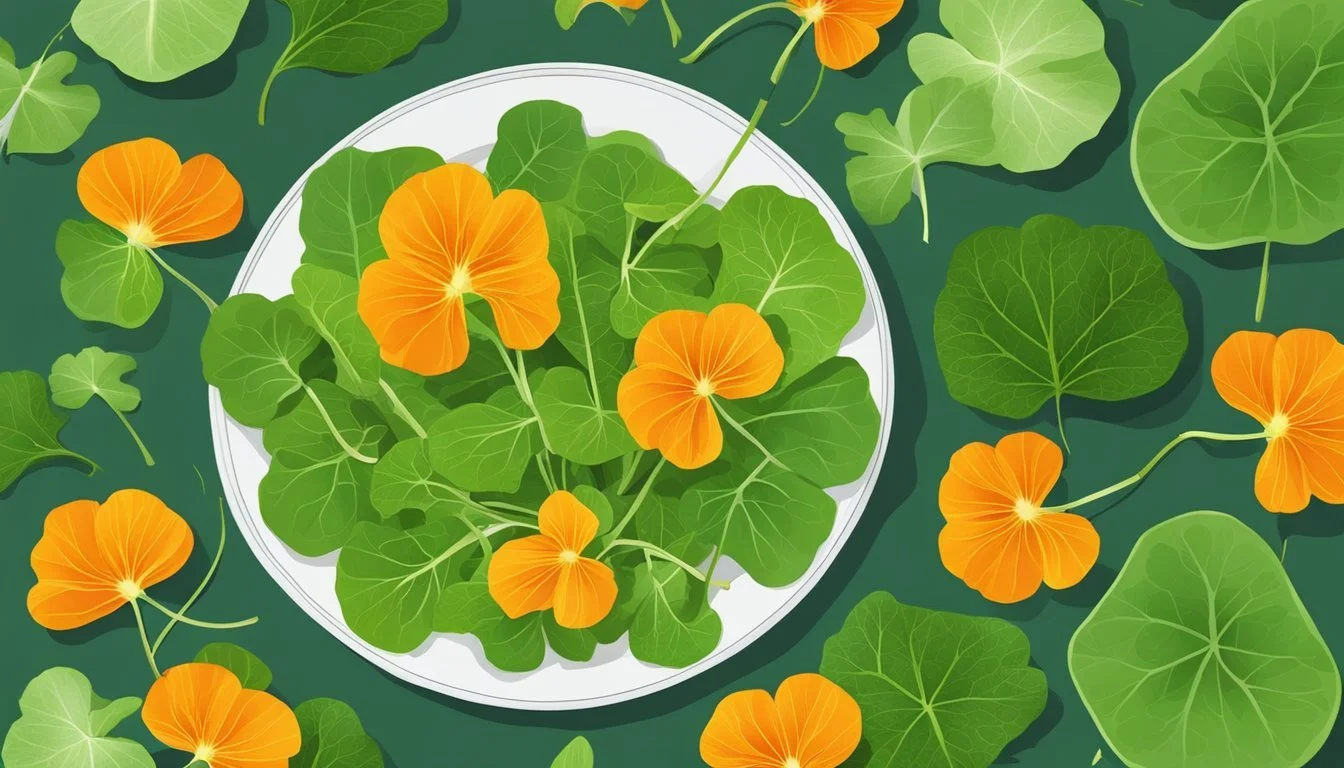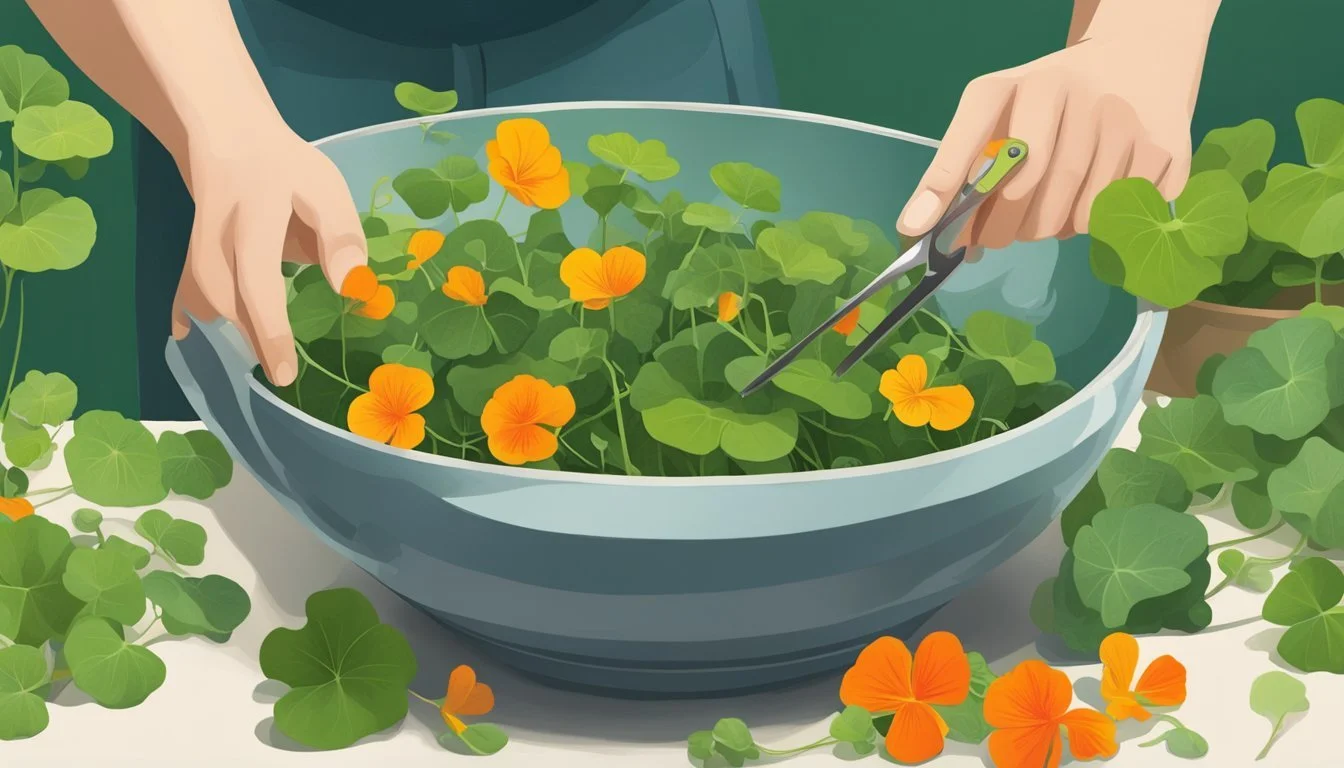How to Substitute Nasturtium Leaves for Watercress
A Simple Guide
Nasturtium leaves offer a vibrant alternative to watercress with their peppery flavor and high vitamin C content. Often used in culinary practices for their noteworthy taste and presentation, they stand as a suitable substitute in dishes where watercress is typically incorporated. Both watercress and nasturtium leaves belong to the mustard family, and they share a similar zest, making nasturtium leaves an ideal stand-in in salads (What wine goes well with salads?) , sandwiches, and garnishes where one might usually leverage the unique characteristics of watercress.
Understanding the textural and flavor nuances between nasturtium leaves and watercress is essential for successfully substituting one for the other. Although nasturtium leaves can be slightly more robust in flavor, they can be used in the same quantity as watercress, ensuring that the dish retains its intended taste profile. They blend well with various ingredients and can enhance the overall sensory experience of a meal, just as watercress does.
When opting for nasturtium leaves in place of watercress, one can expect the dish to exhibit a comparable level of peppery tang and nutrition. The slight differences in texture and the slightly more intense taste of nasturtium leaves should be considered to maintain balance in the dish's flavor palette. Their accessibility and ease of growing at home also contribute to the appeal of using nasturtium leaves as a reliable and beneficial alternative to watercress in many recipes.
Understanding Nasturtium Leaves
Nasturtium leaves are an underused yet versatile leafy green known for their vibrant appearance and distinct flavor profile. They have a round and slightly shield-like shape, with a soft, yet durable texture, making them not only an aesthetic addition to dishes but also an interesting textural component.
The flavor of nasturtium leaves is often described as peppery and somewhat similar to watercress or arugula. This peppery flavor adds a spicy note to salads and cold dishes. Unlike the mild bitterness often associated with leafy greens, nasturtium leaves impart a unique zest that can enliven a variety of recipes.
Here's a brief overview of nasturtium leaves:
Appearance: Rounded and variegated green
Taste: Peppery flavor, less bitter than watercress
Use: Salads, garnishes, and as a vegetable wrap
Nutrition: Rich in Vitamin C and minerals
Their use extends beyond embellishment; they can serve as a stand-alone leafy green in salads or can be used creatively in lieu of other vegetables for wraps or garnishes, offering both flavor and nutrition to dishes. Chefs and home cooks may choose to incorporate nasturtium leaves into their dishes to add a bitter yet appealing taste that complements other ingredients without overwhelming them.
In summary, nasturtium leaves are an adaptable and flavorful alternative to more traditional greens like watercress, providing a subtle yet distinctive peppery note to the culinary palette.
Characteristics of Watercress
Watercress is a highly nutritious leafy vegetable known for its peppery flavor, which makes it a popular choice for various culinary applications.
Nutritional Profile
Watercress provides a rich source of vitamins and minerals. It is particularly high in vitamin K, essential for bone health and blood clotting. The vegetable also contains significant amounts of vitamin A, vitamin C, calcium, and iron. Additionally, it is a good source of potassium and magnesium, which contribute to maintaining healthy blood pressure and muscle function. Below is a table summarizing the key nutritional elements found in watercress:
Nutrient Benefit Vitamin K Supports bone health and blood clotting Vitamin A Benefits eye health Vitamin C Aids in immune function and skin health Calcium Essential for healthy bones and teeth Iron Crucial for oxygen transport in blood Potassium Helps regulate blood pressure Magnesium Important for muscle and nerve function
Common Uses
They commonly utilize watercress in a variety of dishes, thanks to its distinct, peppery taste. One can often find it in fresh salads, adding a punch of flavor and a boost of nutrition. Additionally, watercress serves as an aromatic garnish for soups, contributing both to the visual appeal and the nutrient content of the dish. They frequently use it in sandwiches as well, where it lends a crisp texture and a spicy note, complementing meats and cheeses. Its versatility makes it a favorite vegetable for those looking to enrich their meals with both flavor and health benefits.
Benefits of Nasturtium Leaf Substitution
Nasturtium leaves are an effective substitute for watercress in various dishes such as salads, soups, and sandwiches. They provide a slightly different but still peppery flavor, making them a versatile ingredient in the kitchen.
Nutritional Advantages:
Nasturtium leaves are rich in vitamin C, which contributes to immune defense and skin health.
They contain Vitamin K, essential for blood clotting and bone health.
The presence of folate in nasturtium leaves supports cell growth and metabolism.
Culinary Benefits:
Nasturtium leaves add a unique, peppery punch to dishes, which can enhance the overall taste.
They serve well in both raw and cooked forms, thus adaptable for salads, stews, and as garnishes.
As a garnish, nasturtium leaves and flowers introduce a vibrant aesthetic to meals.
Health Contributions:
These leaves carry antioxidants that help protect the body from oxidative stress.
The antimicrobial properties of nasturtium leaves can contribute positively to one’s health.
Ease of Use:
Nasturtium leaves can be grown easily in home gardens, providing a readily available substitute for watercress.
Substitution Proportions:
Generally, one can substitute nasturtium leaves for watercress in equal proportions, depending on personal taste preferences.
Incorporating nasturtium leaves into dishes can bring not only a flavorful twist but also a healthful edge, making them a beneficial substitute for watercress in many recipes.
Comparison of Flavor Profiles
Watercress is known for its unique flavor profile, characterized by a peppery taste similar to that of radish sprouts. This distinctive peppery bite contributes both a spicy flavor and a touch of bitterness, which can enliven a variety of dishes.
In contrast, nasturtium leaves are a commonly suggested substitute as they possess a similar peppery flavor. Though both nasturtium leaves and watercress share this hallmark peppery zest, they are not identical on the flavor spectrum. Nasturtium leaves tend to impart a slightly more spicy flavor, which may be more pronounced than the gentle bitterness found in watercress.
When replacing watercress with nasturtium leaves, chefs should consider the intensity of the peppery notes. Below is a comparison of the two in terms of their flavor nuances:
Watercress:
Peppery taste with a subtle bitter undertone.
Delicate spicy flavor that is palatable in large amounts.
Nasturtium Leaves:
Bold peppery flavor with a more pronounced spiciness.
Can exhibit a slightly more aggressive bitter taste in comparison to watercress.
Given their flavor similarities, nasturtium leaves can be a viable substitute in dishes that call for watercress. However, they should be used judiciously, particularly in recipes where the peppery flavor of watercress is supposed to be a subtle addition and not the dominant note.
Alternative Watercress Substitutes
While Nasturtium leaves are an excellent substitute for watercress, chefs and home cooks often seek other watercress alternatives that provide a similar peppery punch and nutritive value in dishes ranging from salads to sandwiches.
Leafy Greens
Leafy greens are a staple when it comes to substituting watercress, each offering a distinct taste and texture:
Arugula (also known as rocket or rucola): Adds a spicy kick with its peppery flavor, perfect for salads and sandwiches.
Spinach: Provides a milder, slightly earthy profile, suitable for both raw and cooked applications.
Kale: Known for its hearty, chewy texture and a slightly bitter taste, kale works well in cooked dishes.
Dandelion Greens: Their sharp bitterness mimics watercress and is ideal for a bold flavor.
Lettuce Varieties:
Romaine: Crunchy with a mild taste; a versatile option.
Butterhead (such as Boston or Bibb): Tender and slightly sweet; good for wraps and as a bed for proteins.
Chinese Cabbage: Offers a mild sweetness and can be used in cooked or raw preparations.
Cabbage:
Green Cabbage: Firm texture and a peppery, robust flavor.
Red Cabbage: Adds color and a sharper taste.
Collard Greens: Known for their thick, hearty leaves; ideal for cooking.
Beet Greens: Provide an earthy flavor and are best when cooked.
Herbs and Spices
For seasoning replacements to replicate watercress's zest:
Mustard Greens: They have a peppery, spicy bite, akin to that of watercress.
Purslane: Delivers a lemony undertone alongside a succulent crunch.
Endive: Its crisp texture and bitter flavor is excellent in salads.
Radicchio: Characterized by red, white-veined leaves, offers a bitter and spicy taste.
Water Spinach: Common in Asian cuisine, it brings a mild, sweet flavor and a tender texture.
Upland Cress: A close relative to watercress with a similar peppery note.
Black Pepper: While not a green, it can provide the spicy accent in dressings and dishes that one might miss from watercress.
Culinary Uses of Nasturtium Leaves
Nasturtium leaves provide a peppery flavor similar to watercress which makes them an excellent substitution in a variety of dishes, whether used fresh or cooked. They can enhance salads, pesto, and sandwiches, and serve as a striking garnish.
Salad Creations
Nasturtium leaves can be torn or chopped and added to salads for a spicy note. They pair well with ingredients such as:
Beetroots: For a colorful and earthy salad.
Citrus fruits: Adding a tangy contrast to the peppery leaves.
Nuts: Such as walnuts or pistachios for added crunch.
The leaves' vibrant color and unique flavor also make them suitable for incorporation into pesto recipes or as a base for savory dips. Due to their robust flavor, nasturtium leaves should be used in moderation when raw to avoid overpowering the dish.
Cooking Applications
When cooked, nasturtium leaves' spiciness mellows, allowing them to complement a wide range of recipes:
Stir-fries: Adding the leaves towards the end maintains their color and nutrients.
Pizzas: Sprinkled over the top for an extra zing.
Quiches: Chopped nasturtium leaves can add depth to the flavor.
Cooked nasturtium leaves also go well in sauces and can be blended into smoothies or juices for a nutrient boost. As a garnish, the full leaves or petals can decorate dips, soups, and even desserts for an edible, pepper-flavored flourish.
Gardening Tips for Nasturtiums
When growing nasturtiums, gardeners should consider their dual purpose: both as garnishes and vibrant flowers that can discourage weeds. This herb is prized for its edible qualities and ease of care.
Location & Planting: Nasturtiums thrive in full to partial sunlight. They prefer a well-drained soil but can adapt to a range of soil types. Gardeners should plant them after the last frost, spacing them about 10 to 12 inches apart to allow for adequate airflow and growth.
Soil & Watering: While nasturtiums are not fussy, soil that is too rich will encourage more foliage than flowers. A balanced, well-draining soil is ideal. Regular watering helps, but allow the soil to dry out slightly between watering to promote flowering.
Pest Management: These cheerful flowers can serve as a companion plant in the garden, acting as a trap crop for aphids.
Fertilizing: Fertilizer is often unnecessary, as too much can decrease the amount of blooms. If needed, opt for a low-nitrogen option.
Care Aspect Detail Soil Type Well-draining Watering Moderate, allow drying between Sunlight Full to partial Spacing 10-12 inches apart Fertilizer Low-nitrogen, if at all
When it comes to harvesting, both leaves and flowers can be picked and used for garnishes or to add a peppery flavor to dishes, much like watercress. By following these straightforward tips, gardeners can enjoy the full spectrum of benefits nasturtiums bring to the garden and the kitchen.
Health Considerations When Swapping Greens
When substituting nasturtium leaves for watercress in a recipe, one should consider the nutritional profiles of both greens to maintain a healthy lifestyle. Nasturtium leaves and watercress are both regarded as nutritious, though their content varies slightly.
Nasturtium Leaves:
Vitamin C: They are a good source of vitamin C, which is crucial for immune function.
Nutrients: Contain unique plant compounds that may have health benefits.
Low in Calories: Ideal for those monitoring their calorie intake.
Watercress:
Often dubbed a superfood, watercress is dense in nutrients while being low in calories.
Vitamins A and K: It is particularly high in vitamins A and K, contributing to vision health and blood clotting.
Both greens are considered fresh when they are vibrant in color and crisp to the touch, a sign they are retaining their nutrients. A diverse diet including a variety of greens can provide a range of nutrients vital for health. Those incorporating greens as part of a healthy lifestyle might aim for variety to cover all nutrient bases.
However, one should cautiously approach the change if there are specific dietary restrictions or health concerns such as allergies. The two greens can typically be swapped in equal proportions in most recipes without significantly altering the dish’s nutritional value.
Nutrient Nasturtium Leaves Watercress Calories Low Low Vitamin C Good source Sufficient Vitamins A/K Present High in A and K
By considering these factors, one ensures that the swap aligns with nutritional needs and healthy eating goals.
Shopping Guide for Leafy Greens
When visiting a supermarket to select leafy green vegetables as substitutes for watercress or nasturtium leaves, shoppers should prioritize freshness and quality. Here's a straightforward guide to help make informed choices:
Identifying Freshness:
Look for vibrant color: Fresh greens like kale and arugula should have a bright, rich color.
Check for crispness: Leaves should be firm and snap back when gently bent.
Avoid wilted or yellowing leaves: These are signs of age or poor storage.
Optimal Storage Conditions:
Supermarket: Verify that the greens are properly refrigerated.
Home: Store greens in a sealed container or plastic bag with a paper towel to absorb excess moisture.
Variety Selection:
Watercress: Small, round leaves with a distinctive peppery flavor. Best for salads and garnishes.
Nasturtium Leaves: Larger with a similar peppery taste. Suitable for salads and as edible garnishes.
Kale: More robust with a bitter note. Great for sautés and smoothies.
Arugula: A peppery alternative, excellent in salads and as a pizza topping.
Organic vs. Conventional:
Consider organic options to reduce exposure to pesticides.
If budget constraints limit organic purchases, opt for conventional and wash thoroughly.
Practical Tips:
Seasonality: Purchase during peak seasons for the best flavor and value.
Bulk Buying: If purchasing large amounts, ensure proper storage to maintain freshness.
Taste Testing: If possible, taste a leaf to ensure it meets the flavor profile you seek.
Adhering to these guidelines ensures that individuals choose the best quality leafy greens for their culinary needs, whether they are substituting watercress, nasturtium leaves, or simply adding variety to their vegetable intake.
Cultural Significance and History
Nasturtium, with its vibrant flowers and edible leaves, has woven its way through various cultures, carrying both culinary and symbolic value. Known in some regions as Indian cress or early yellow rocket, it hails from the Brassicaceae family, closely related to watercress and mustard.
Usage in Different Cuisines
Nasturtium leaves are cherished for their peppery taste reminiscent of watercress, contributing a spicy note to salads and garnishes. In European cuisine, they often accompany dishes as a decorative and flavorful element. Asia, with its diverse palate, also incorporates similar leaves from the mustard family into its culinary practices, though nasturtium is not as commonly used in traditional Asian dishes. Its botanical name, Tropaeolum majus, might not be as familiar in the kitchens of Europe and Asia, but the plant itself has been recognized for its culinary versatility.
As a substitute for watercress, nasturtium leaves provide a similar punch of flavor, making them ideal in recipes that call for a bright, peppery component. They are rich in nutrients, and their bold hues add an aesthetic appeal to any dish.











